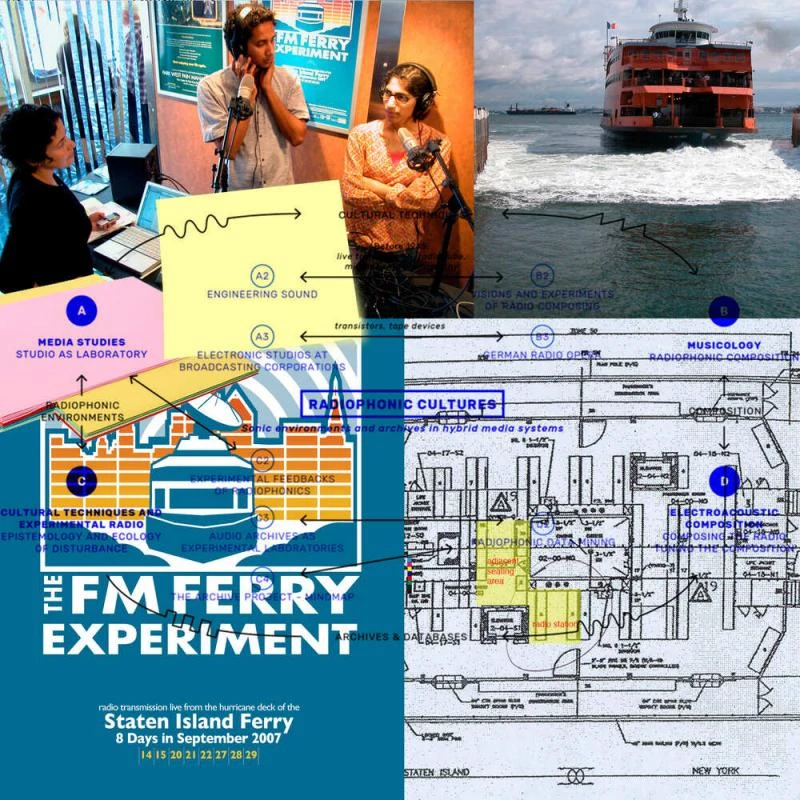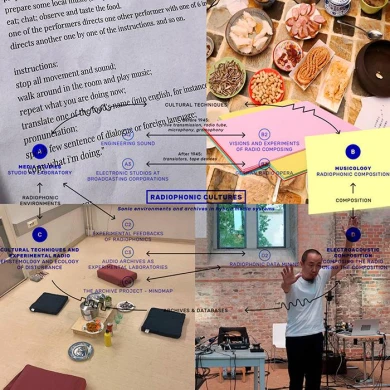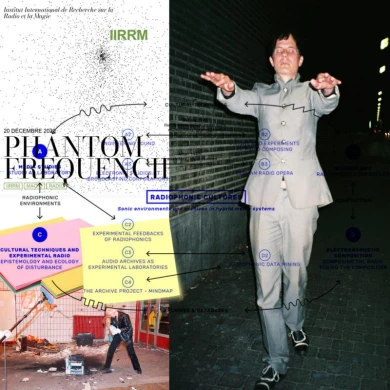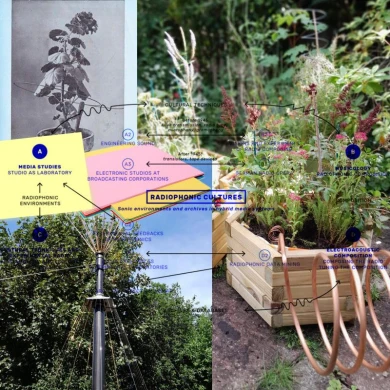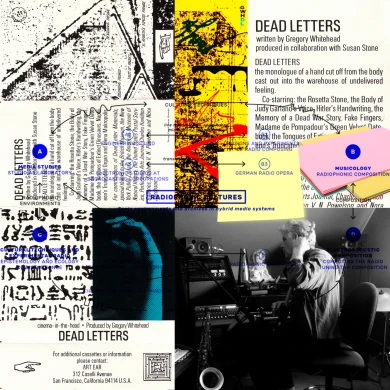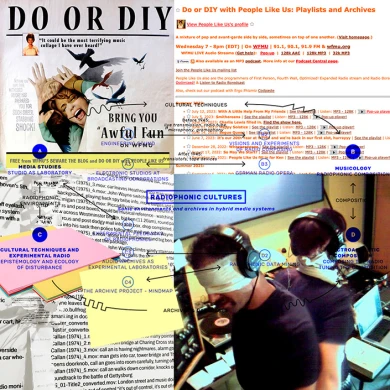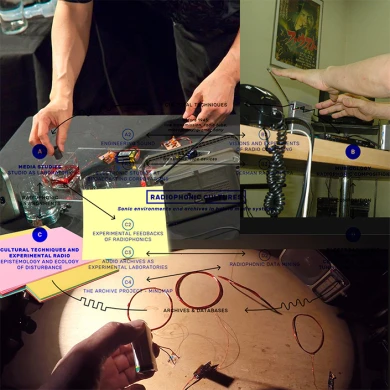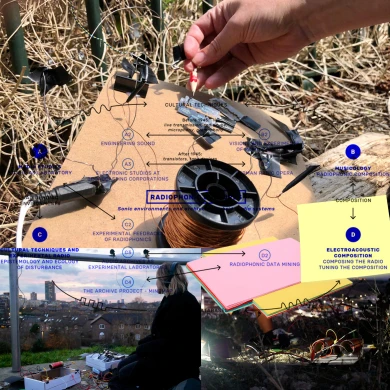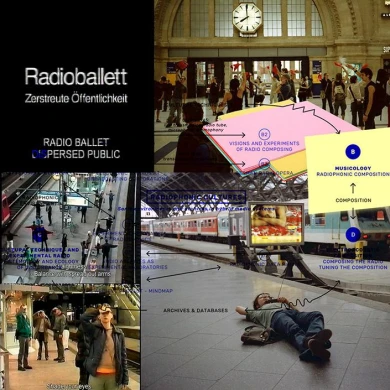[Clip from The FM Ferry Experiment (2007)]:
“—Valerie Tevere: Hello, this is Valerie Tevere of the FM Ferry Experiment. We are broadcasting from the hurricane level of the Molinari today.
(Voice over the PA system): All passengers must depart the ferry at this time. All passengers must depart the ferry at this time. All passengers must depart the ferry at this time. Passengers wishing to make the return trip must exit into the terminal and into the waiting room to await the next ferry.
—Valerie Tevere: Yes, you must depart the ferry at this time, but re-board for the 12:30 ship on Whitehall side. This is the FM Ferry Experiment, and you've just been listening to…
(Voice over the PA system): All passengers must depart the ferry at this time. All passengers must depart the ferry at this time. All passengers must depart the ferry at this time. Passengers wishing to make the return trip must exit into the terminal and into the waiting room to await the next ferry.
— Valerie Tevere: That was New Report Artist Unknown by K8 Hardy and Wynne Greenwood. Now up next, we have a number of songs track listed for you.
(Voice over the PA system): All passengers must depart the ferry at this time. All passengers must depart the ferry at this time. All passengers must depart the ferry at this time. Passengers wishing to make their trip must exit the end of the tunnel and into the waiting room to await the next ferry.”
—Angel Nevarez: I am Angel Nevarez.
—Valerie Tevere: And I am Valerie Tevere.
—Angel Nevarez: We are artists based in Brooklyn, New York, who have worked together for over twenty four years. From the years 2001 to 2008, we worked under the collective name neuroTransmitter.
—Valerie Tevere: The work we created during this period fused conceptual practices with transmission, sound production, and mobile broadcast design. We utilized a combination of media forms and sound performance, and our work re-articulated radio in multiple environments and contexts.
[Clip from a neuroTransmitter performance]:
“—Male voice: All the living creatures, for instance, are continually affecting the environment. The environment becomes changed, and the changed environment affects the creatures. This is the way in which the universe is evolving. Therefore, change is constant, and change is normal. It's only since Einstein that change has become normal.”
—Valerie Tevere: In 2001, together on a rooftop in the Bronx, New York, we collaborated on a sound project that utilized the FM airwaves through a very local pirate radio broadcast. It was for an exhibition where we set up our low power transmitter on the roof of the gallery, alongside musical instruments, audio recordings, and audio interviews of local neighbors. Inside the gallery, we installed a radio picking up our signal. It was our first collaboration, and we've been collaborating ever since.
—Angel Nevarez: From that first project, we continued on working medium specifically, where we gave ourselves a task to produce works that utilized or referenced radio histories, architectures, broadcasts and/or alternative transmissions. This opened up many possibilities that led to the creation of graphic works, architectural models, videos, wearable broadcast systems, and other aesthetic forms. We also created temporary radio stations in various cities like New York, Munich, Berlin, Mexico City and other locations.
—Valerie Tevere: A certain form of empowerment comes with the possibility to send and receive messages, signals, sound, music, the voice, etc., over the ether. In this way, the use of radio for us felt autonomous and unfettered. These modes of collaboration went on from 2001 to 2008 under the collective name neuroTransmitter.
—Angel Nevarez: From the very beginning of our work with radio, we always considered the airwaves as a public space to be occupied and utilized by many publics. The use of radio as public space, alongside current artistic practices like social engagement and community-based projects have merged under this medium-specific work.
—Valerie Tevere: If we consider the airwaves as a form of public space, then what we are really considering is an openness of the ether, moving radio more toward the spheres of deregulation, decorporatization, and demilitarization, with possibilities of more creative forms of interaction with the medium. In the context of the U.S. all forms of communication are governed by the Federal Communications Commission. The FCC holds a tight grip on radio broadcast and primarily makes it illegal for non-licensed entities to freely broadcast on any frequency. Therefore, we see the continued use of the term ‘pirate radio’ as a political and performative act of defiance. Pirate radio is a tactic that undermines corporate media domination and occupies the privatized space of radio bandwidth for non-commercial interests.
—Angel Nevarez: Historically, government control of the airwaves can also be observed internationally. Well-known initiatives of circumventing government control stem from the 1960s and 70s in the U.K. and other parts of Europe. Radio Caroline was an active ship that would broadcast from international waters outside of the U.K. boundaries where national terrestrial laws would not abide, and DJs could broadcast freely.
[Clip from Radio Caroline]:
“(Jingle): Caroline, the sound of the nation. Caroline, the sound of the land. Caroline, the sound of the nation. Caroline!
—Tony Blackburn: Yes. Indeed. Good morning, everyone. Tony Blackburn here with you feeling a little under the weather this morning. We've got about an eight force gale out there, so I'm strapped in the seat this morning. Hoping that you're gonna enjoy all the music. This is number one in the countdown this week from the Spencer Davis group. It's called Keep On Running.
(Song ‘Keep on Running’ by Spencer Davis).”
—Valerie Tevere: 12 Miles Out is an installation we created that specifically references Radio Caroline. A wire drawing attached to a wall is both a functioning antenna and visually represents a Radio Caroline ship circa 1964. Our broadcast audio composition mixes live and ambient sound recordings of an ocean voyage taken out into international waters with archival materials from Radio Caroline broadcasts and commentary that references offshore pirate radio and the shifts in territorial boundaries that govern the sea. Listeners were able to tune their radios to the project's local frequency transmission.
[Clip from The FM Ferry Experiment (2007)]:
“(Voice over the PA system): May I have your attention, please? Welcome aboard the Staten Island Ferry.
—Male presenter: The airwaves meet the water waves. Stay tuned to the FM Ferry Experiment coming to you live from the hurricane level of the Staten Island Ferry on WSIA 88.9 FM.
(Voice over the PA system): Thank you for riding the Staten Island ferry.”]
—Angel Nevarez: Our project from 2007, the FM Ferry Experiment, was also an homage to the floating radio stations of the past. For eight days in September of 2007, we set up a temporary radio station on the Staten Island Ferry, a commuter boat that moves passengers to and from Lower Manhattan and Staten Island. This was a unique combination of civic and public space and a collaboration with a college radio station whose FCC license made it all possible.
—Valerie Tevere: From 2004 to 2007, in collaboration with the New York City Department of Transportation and the student-run radio station WSIA FM, we developed the process and technology toward the first-ever radio broadcast from the Staten Island Ferry. (Cinematic music sounds). This was an 8-day [A1] mobile radio project that occurred during the month of September in 2007, and it was a sonic experiment in cooperation across spatial practices, the airwaves, and public commuter space.
—Angel Nevarez: The Staten Island Ferry is a public transport vessel that moves commuters between Lower Manhattan and the North Shore of Staten Island. It is the only free form of public transportation across New York City. Tourists often board the ferry for the scenic views across Upper New York Bay, which includes the Statue of Liberty.
[Clip from The FM Ferry Experiment (2007)]:
“—Male presenter: You are listening to the podcast edition of the FM Ferry Experiment, a radio project of neuroTransmitter in cooperation with the New York City Department of Transportation and WSIA FM. This is Day 3, Part 1 of eight days of programming that occurred in September of 2007. For more information, go to www.fmferryexperiment.net. From my own personal experience, I've seen the work that Angel and Valerie have been doing on this project, and I thought it was very interesting, and I think you will all enjoy it.
(Ship horn and water waves sounds…).”
—Angel Nevarez: The FM Ferry Experiment brought together the public broadcast potential of the airwaves with the Maritime Commuter Venue in order to expand the social space and architecture of the ferry out into the ether while engaging various publics and audiences on the ferry and on the radio.
—Valerie Tevere: In order to bring together the public commuter space and the airwaves, we utilized the medium of FM radio along with live performance and produced programs with theme variations, from the ecology and the microbiology of the immediate water system to urban myths, historical projections, public and private space surveillance, along with the collusion of the maritime industry and global commodities.
[Clip from The FM Ferry Experiment (2007)]:
“(Background noises of people talking and water waves…).”
—Valerie Tevere: We were interested in sonically and spatially activating the space of the ferry, considering what is existent in and around the ferry, its architecture, mode of transport, and what is present above and below its surface as it moves through the New York waterways.
—Angel Nevarez: For much of the content of the radio broadcast themselves, we invited a number of artists, musicians and experts in the fields of marine biology, geography, radio, and sound art to produce works for the project. The live engineered programs were transmitted to New York City radio listeners via WSIA FM and to international audiences via internet broadcast. The FM Ferry Experiment extended our research interests that mined the content of radio and how it is structured while questioning the executive decision-making and corporate influence between what is eventually broadcast.
[Clip from 5th Annual New York City Avant Garde Festival]:
“—Henry Stein-Acker-Hill: Good evening and welcome to WKRH News, where we are always pregnant with information. I’m Henry Stein-Acker-Hill reporting to you from a WKRH studio. This just in: paintings thrown out. The story being born tonight is upsetting and upset. We are following an anonymous tip that has told us a woman was seen throwing out her canvases. Henry Irigaray is live right outside of our studios. Actually, she’s in search of those canvases.
— Henry Irigaray: This is Henry Irigaray reporting to you live from the streets of a contemporary art neighborhood in New York City. And I am going on location to where our caller has tipped us off that a woman artist has dumped her paintings, her vibrant paintings, into the trash.
—Henry Stein-Acker-Hill: Henry, what do you know about this anonymous tip? Do we know who the artist was?
— Henry Irigaray: All we know from our anonymous call-in is that someone saw someone throw away paintings in the trash, vibrant in color, and I'm on the street now live to investigate this.”
—Valerie Tevere: The radio of the future is an interesting concept to consider. Back in 2022, for a series of radio-based projects presented in Luxembourg, we reimagined the classic radio drama War of the Worlds by Orson Welles as a 22-hour sound piece, where we literally stretched the audio's waveform to last the duration of 22 hours. Conceptually, we framed it as if Orson Welles broadcast frequencies from his original 1932 airing. We turned to the earth local ether from the outer corners of the universe, resounding in a future scenario and context. As frequencies know no boundaries, why couldn't they go beyond our atmosphere and into other universes and potentially return? This thought experiment considers that a broadcast aired today can imaginably someday in the future return to us transformed anew.
—Angel Nevarez: And further considering the radio of the future on a more technological front, we imagine it as important and urgent in future scenarios simply because it is a less complicated analog mode of communication. When emergencies happen and the power goes down, one can still listen to the radio, as both the radio and the transmitter can be either powered by battery or have energy sourced from the sun. This is obviously not the case with digital media like satellite or internet radio. As the climate crisis heightens and governments clamp down on free speech and assembly, a return to so-called terrestrial radio practices will likely gain a resurgence of content creators and followers.
[Clip from the song The World is Big, The World is Small by Ella Jenkins]
